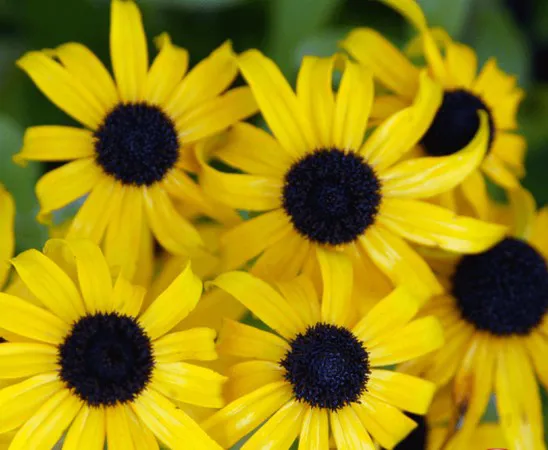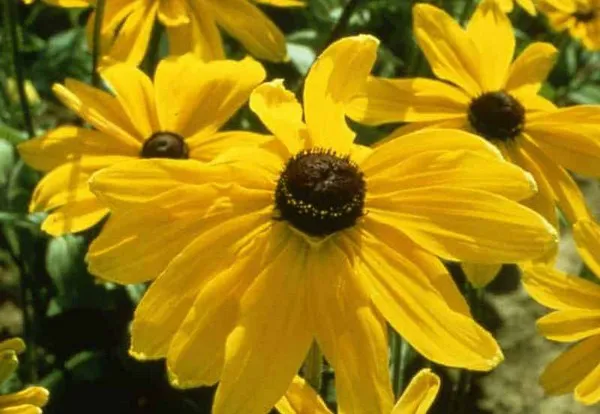Widely known as black-eyed Susan, this North American native can be found growing as a wildflower in fields and along roadsides throughout the country. These reliable plants shine in the garden with an abundance of brightly colored flowers reflecting the brilliant yellows and oranges of the summer sun. Rudbeckias are easy to grow, adapt to a wide range of garden conditions, have few insect or disease problems, and require only minimal care for a spectacular show of cheerful color during the summer and fall.
Classification and varieties
There are 25 species of Rudbeckia that are native to North America and are generally found growing in the East and Midwest, though they have now naturalized throughout most of the United States and can be seen in fields and gardens from Canada to Mexico.
A member of the Aster family, the rudbeckia’s daisy-like flowers come in single, semi-double, and fully double forms in a range of colors from lemon-yellow to gold, chestnut, mahogany, and bronze, as well as multi-colored blooms. Most species are in bloom from midsummer through fall. Plants have coarse-textured, hairy green leaves.
Native to the eastern and midwestern prairies, the brown-eyed Susan (Rudbeckia triloba) is covered with a surplus of dainty, 1- to 2-inch yellow flowers with button-like black centers that fade to brown. This biennial or short-lived perennial is hardy in zones 4-7 but can also be grown as an annual. Plants are 2- to 5-feet tall depending on the growing conditions.
Rudbeckia laciniata is a perennial type commonly called cutleaf coneflower or ragged coneflower. Its most famous representative is the old-fashioned heirloom ‘Golden Glow.’ Plenty of room is needed to grow this plant as it can spread 6 feet across.
Rudbeckia American Gold Rush
Petals of Rudbeckia fulgida (orange coneflower) are not true orange but a warm yellow. A popular choice has been Rudbeckia fulgida var. sullivantii Goldsturm until the new AAS Winner American Gold Rush came on the scene. It was trialed against Goldsturm and was found to be superior in habit, plant health, flower power, and bloom time. Bright golden-yellow flowers are on upright domed-shaped plants that grow to a compact 24” tall. This newest AAS Winner was especially praised for its ability to resist Septoria leaf spot.

Gold rush
The largest group of rudbeckias for the garden is Rudbeckia hirta. Flowers bloom from July until frost in shades of orange, orange-yellow, and yellow. Rudbeckia hirta is a short-lived perennial and is grown as an annual in Northern areas. Plants are biennial or perennial in Southern regions.

Indian summer
Indian Summer is an All-America Selections (AAS) winner from 1995. It produces stunning 5- to 9-inch flowers on plants that reach about 3-feet tall. The golden-yellow flowers are ideal for cutting. Another AAS winner is Cherokee Sunset. The semi-double and double, 2- to 4-inch, flowers bloom in shades of yellow, orange, bronze, and mahogany. Plants reach about 30-inches tall.
A newer Rudbeckia hirta is Rudbeckia Amarillo Gold, a 2020 AAS Winner. It boasts of 4-6” blooms on compact and uniform 12-18” plants that are perfect for landscapes, bedding, and containers.

Amarillo gold
Looking for something different? The 2003 AAS winner Prairie Sun produces spectacular 5-inch blooms with golden-yellow petals tipped with a brush of lighter primrose yellow surrounding a striking, light-green center cone. The 3-foot tall branching plants can be grown in gardens and large containers. Or the older, 1961 AAS Winner Gloriosa Double sports rich, golden double flowers that are 3 ½” across with large black centers. This beauty also grows to 3’ tall.
Garden Uses
Rudbeckias are versatile plants that add bright sunny color to perennial beds, mixed borders and containers. They can be used alone in mass plantings, as a border, or along a fence. Ideal for attracting wildlife, bees and butterflies are drawn to their colorful flowers while the ripe coneheads provide seed during the fall and winter to feed hungry birds, especially finches and chickadees.

 All-America Selections
All-America Selections